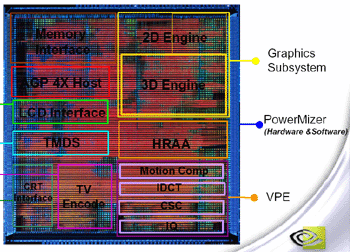The Chip
Like the jump made by ATI from the Mobility Radeon chip to the Mobility Radeon 7500, the jump NVIDIA took going from the GeForce2 Go to the GeForce4 Go was nothing short of impressive. Let's see what is behind NIVIDA's latest mobile solution.
You may recall that both ATI and NVIDIA base their mobile graphics parts on modified versions of desktop chips. This makes the most sense for the companies, as new desktop technology can be adapted for mobile use. The ATI Mobility Radeon 7500 was based off the desktop ATI Radeon 7500 core. NVIDIA based the GeForce4 Go chips on the GeForce4 MX line of cards.
The GeForce4 Go series is made up of three products: the GeForce4 410 Go, the GeForce4 420 Go, and the GeForce4 440 Go. Each is based off a modified version of the the GeForce4 MX core with the only difference between the chips being in memory size/speed and core speed. There are actually two different breeds of two of the three chips but we'll get to that in a minute.
The entire GeForce4 Go series chips are built on a 0.15 micron process, just like the NV17 that they are based on. Not only did this decrease power consumption compared to the older 0.18 micron GeForce2 Go, it also allowed NVIDIA to pack more components into a tight space; both items crucial for mobile chip success. Like the GeForce4 MX desktop chips, the GeForce4 Go chips feature two pixel pipelines that are able to apply two textures per pipeline (creating half the theoretical fill rate of an equivalently clocked desktop GeForce4).
The chips also feature the lightspeed memory architecture II that was first introduced in the GeForce4 line, but like the GeForce4 MX chips, the LMA II implementation has 2 x 64-bit load balanced memory controllers (compared to the GeForce4's 4 x 32-bit memory controllers). Also like the desktop GeForce4 MX, the GeForce4 Go chips feature the Accuview AA engine, T&L engine, nView support, and an improved Visibility Subsystem.
What is missing from the GeForce4 Go? Well, the same things that are missing from the GeForce4 MX line of cards. This includes the nfiniteFX engine, which leaves the GeForce4 Go without DirectX 8 pixel shaders and only limited support for vertex shaders. This puts the feature specs right in line with the Mobility Radeon 7500 which also does not include DirectX 8 pixel and vertex shader support.
Of course, since the GeForce4 Go is a mobile solution, some things had to be added to the core to make it ready for use in a notebook. By far the largest chip difference between the GeForce4 Go chips and the GeForce4 MX is the addition of PowerMizer technology.

PowerMizer is a hardware and software power saving solution that helps decrease the battery drain of the graphics chip and thus increase battery life. PowerMizer is now on its second implementation on the GeForce4 Go chips, and things have changed for the better. As one would suspect, a powerful mobile graphics solution has the potential to drain a significant amount of power. To address this issue, PowerMizer attempts to conserve as much power as possible. This is done using the following methods.
First off, the GeForce4 Go chips have the ability to dynamically clock gate. This means that blocks of the chip that are not being used can be turned off. For example, when the GeForce4 Go is only drawing a 2D environment on the notebook's LCD panel, the only parts of the chip that would be active are the 2D engine, the LVDS and the memory interface. The 3D engine, video processing engine and the display encoders would all be turned off, decreasing the power consumption of the chip.










0 Comments
View All Comments